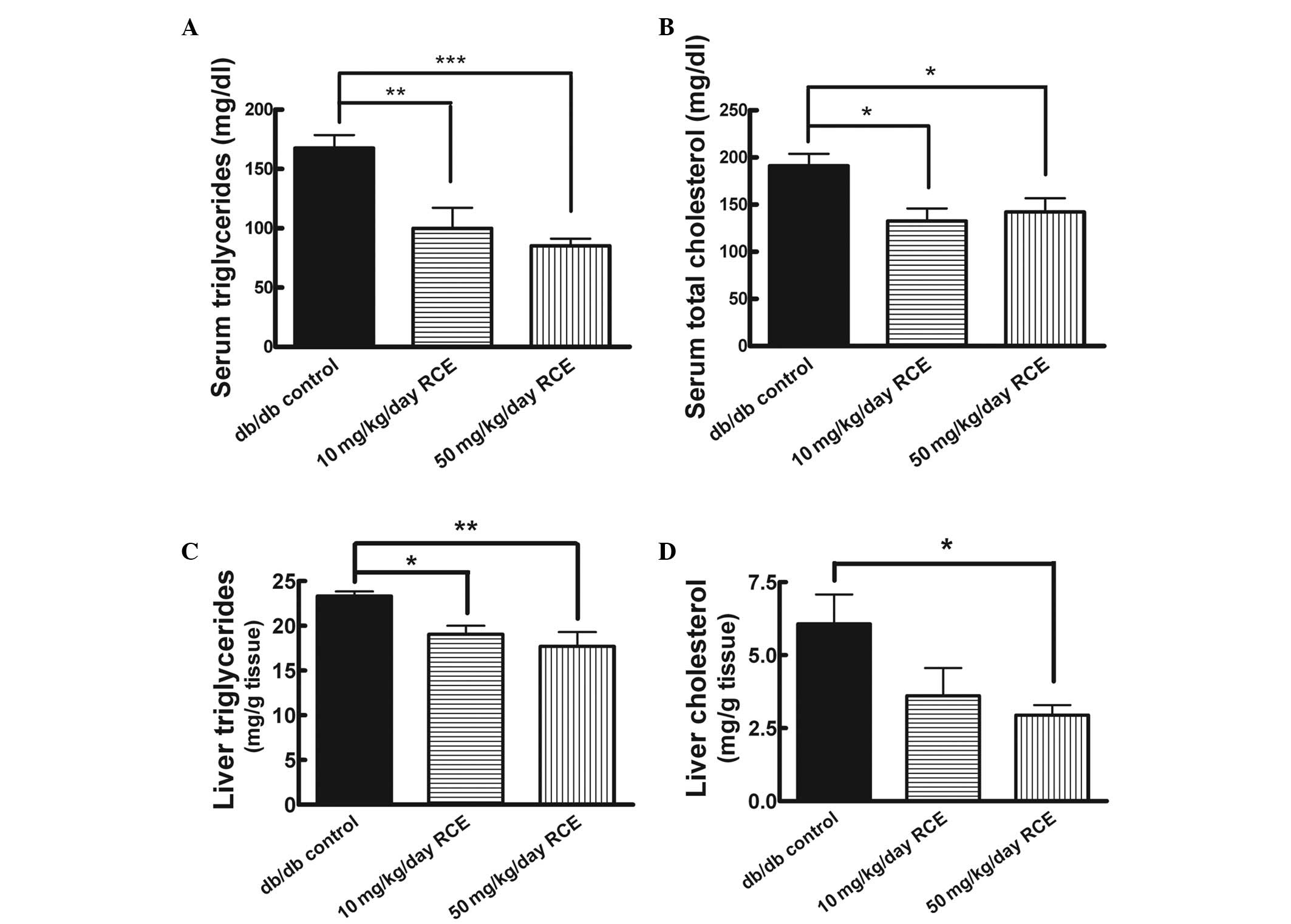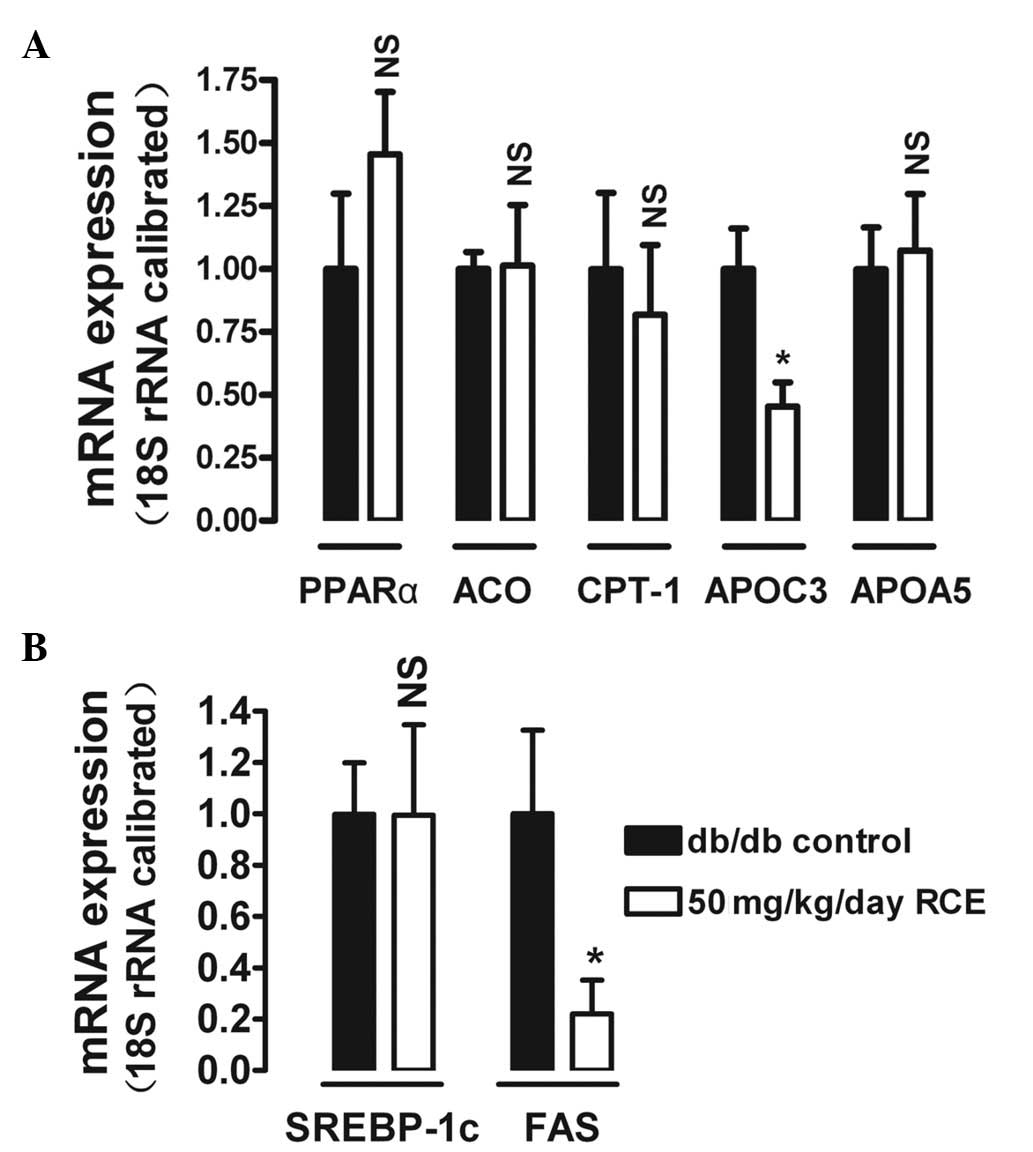|
1
|
Wong MC, Emery PW, Preedy VR and Wiseman
H: Health benefits of isoflavones in functional foods? Proteomic
and meta-bonomic advances. Inflammopharmacology. 16:235–239. 2008.
View Article : Google Scholar : PubMed/NCBI
|
|
2
|
Usui T: Pharmaceutical prospects of
phytoestrogens. Endocr J. 53:7–20. 2006. View Article : Google Scholar : PubMed/NCBI
|
|
3
|
Bhathena SJ and Velasquez MT: Beneficial
role of dietary phytoestrogens in obesity and diabetes. Am J Clin
Nutr. 76:1191–1201. 2002.PubMed/NCBI
|
|
4
|
Lee JS: Effects of soy protein and
genistein on blood glucose, antioxidant enzyme activities, and
lipid profile in streptozotocin-induced diabetic rats. Life Sci.
79:1578–1584. 2006. View Article : Google Scholar : PubMed/NCBI
|
|
5
|
Mezei O, Banz WJ, Steger RW, Peluso MR,
Winters TA and Shay N: Soy isoflavones exert antidiabetic and
hypolipidemic effects through the PPAR pathways in obese Zucker
rats and murine RAW 264.7 cells. J Nutr. 133:1238–1243.
2003.PubMed/NCBI
|
|
6
|
Jayagopal V, Albertazzi P, Kilpatrick ES,
et al: Beneficial effects of soy phytoestrogen intake in
postmenopausal women with type 2 diabetes. Diabetes Care.
25:1709–1714. 2002. View Article : Google Scholar : PubMed/NCBI
|
|
7
|
Li Z, Hong K, Saltsman P, et al: Long-term
efficacy of soy-based meal replacements vs an individualized diet
plan in obese type II DM patients: relative effects on weight loss,
metabolic parameters, and C-reactive protein. Eur J Clin Nutr.
59:411–418. 2005. View Article : Google Scholar : PubMed/NCBI
|
|
8
|
Gobert CP, Pipe EA, Capes SE, Darlington
GA, Lampe JW and Duncan AM: Soya protein does not affect glycaemic
control in adults with type 2 diabetes. Br J Nutr. 103:412–421.
2009. View Article : Google Scholar : PubMed/NCBI
|
|
9
|
González S, Jayagopal V, Kilpatrick ES,
Chapman T and Atkin SL: Effects of isoflavone dietary
supplementation on cardiovascular risk factors in type 2 diabetes.
Diabetes Care. 30:1871–1873. 2007.PubMed/NCBI
|
|
10
|
Qiu L, Ye H, Chen L, Hong Y, Zhong F and
Zhang T: Red clover extract ameliorates dyslipidemia in
streptozotocin-induced diabetic C57BL/6 mice by activating hepatic
PPARα. Phytother Res. 26:860–864. 2012.PubMed/NCBI
|
|
11
|
Kota BP, Huang TH and Roufogalis BD: An
overview on biological mechanisms of PPARs. Pharmacol Res.
51:85–94. 2005. View Article : Google Scholar : PubMed/NCBI
|
|
12
|
Shen P, Liu MH, Ng TY, Chan YH and Yong
EL: Differential effects of isoflavones, from Astragalus
membranaceus and Pueraria thomsonii, on the activation
of PPARalpha, PPARgamma, and adipocyte differentiation in vitro. J
Nutr. 136:899–905. 2006.PubMed/NCBI
|
|
13
|
Inoue M, Ohtake T, Motomura W, et al:
Increased expression of PPARgamma in high fat diet-induced liver
steatosis in mice. Biochem Biophys Res Commun. 336:215–222. 2005.
View Article : Google Scholar : PubMed/NCBI
|
|
14
|
Kim SY, Kim HI, Park SK, et al: Liver
glucokinase can be activated by peroxisome proliferator-activated
receptor-gamma. Diabetes. 53(Suppl 1): S66–S70. 2004. View Article : Google Scholar : PubMed/NCBI
|
|
15
|
Mueller M, Hobiger S and Jungbauer A: Red
clover extract: a source for substances that activate peroxisome
proliferator-activated receptor alpha and ameliorate the cytokine
secretion profile of lipopolysaccharide-stimulated macrophages.
Menopause. 17:379–387. 2010.
|
|
16
|
Qiu L, Lin B, Lin Z, Lin Y, Lin M and Yang
X: Biochanin A ameliorates the cytokine secretion profile of
lipopolysaccharide-stimulated macrophages by a PPARγ-dependent
pathway. Mol Med Report. 5:217–222. 2012.PubMed/NCBI
|
|
17
|
Guo L and Tabrizchi R: Peroxisome
proliferator-activated receptor gamma as a drug target in the
pathogenesis of insulin resistance. Pharmacol Ther. 111:145–173.
2006. View Article : Google Scholar : PubMed/NCBI
|
|
18
|
Ronis MJ, Chen Y, Badeaux J and Badger TM:
Dietary soy protein isolate attenuates metabolic syndrome in rats
via effects on PPAR, LXR, and SREBP signaling. J Nutr.
139:1431–1438. 2009. View Article : Google Scholar : PubMed/NCBI
|
|
19
|
Asgary S, Moshtaghian J, Naderi G, et al:
Effects of dietary red clover on blood factors and cardiovascular
fatty streak formation in hypercholesterolemic rabbits. Phytother
Res. 21:768–770. 2007. View
Article : Google Scholar : PubMed/NCBI
|
|
20
|
Geller SE and Studee L: Soy and red clover
for mid-life and aging. Climacteric. 9:245–263. 2006. View Article : Google Scholar : PubMed/NCBI
|
|
21
|
Lukaczer D, Darland G, Tripp M, et al:
Clinical effects of a proprietary combination isoflavone
nutritional supplement in menopausal women: a pilot trial. Altern
Ther Health Med. 11:60–65. 2005.PubMed/NCBI
|
|
22
|
Schult TM, Ensrud KE, Blackwell T,
Ettinger B, Wallace R and Tice JA: Effect of isoflavones on lipids
and bone turnover markers in menopausal women. Maturitas.
48:209–218. 2004. View Article : Google Scholar : PubMed/NCBI
|
|
23
|
Haines C, James A, Sahota D, et al:
Comparison between phytoestrogens and estradiol in the prevention
of atheroma in ovariectomized cholesterol-fed rabbits. Climacteric.
9:430–436. 2006. View Article : Google Scholar : PubMed/NCBI
|
|
24
|
Howes JB, Sullivan D, Lai N, et al: The
effects of dietary supplementation with isoflavones from red clover
on the lipoprotein profiles of post menopausal women with mild to
moderate hypercholesterolaemia. Atherosclerosis. 152:143–147. 2000.
View Article : Google Scholar
|
|
25
|
Lefebvre P, Chinetti G, Fruchart JC and
Staels B: Sorting out the roles of PPAR alpha in energy metabolism
and vascular homeostasis. J Clin Invest. 116:571–580. 2006.
View Article : Google Scholar : PubMed/NCBI
|
|
26
|
Auwerx J, Schoonjans K, Fruchart JC and
Staels B: Transcriptional control of triglyceride metabolism:
fibrates and fatty acids change the expression of the LPL and apo
C-III genes by activating the nuclear receptor PPAR.
Atherosclerosis. 124(Suppl): S29–S37. 1996. View Article : Google Scholar
|
|
27
|
Vu-Dac N, Gervois P, Jakel H, et al:
Apolipoprotein A5, a crucial determinant of plasma triglyceride
levels, is highly responsive to peroxisome proliferator-activated
receptor alpha activators. J Biol Chem. 278:17982–17985. 2003.
View Article : Google Scholar
|
|
28
|
Qiu L, Wu X, Chau JF, et al: Aldose
reductase regulates hepatic peroxisome proliferator-activated
receptor alpha phosphorylation and activity to impact lipid
homeostasis. J Biol Chem. 283:17175–17183. 2008. View Article : Google Scholar
|
|
29
|
Semenkovich CF: Regulation of fatty acid
synthase (FAS). Prog Lipid Res. 36:43–53. 1997. View Article : Google Scholar : PubMed/NCBI
|
|
30
|
Horton JD and Shimomura I: Sterol
regulatory element-binding proteins: activators of cholesterol and
fatty acid biosynthesis. Curr Opin Lipidol. 10:143–150. 1999.
View Article : Google Scholar : PubMed/NCBI
|
|
31
|
Horton JD, Goldstein JL and Brown MS:
SREBPs: activators of the complete program of cholesterol and fatty
acid synthesis in the liver. J Clin Invest. 109:1125–1131. 2002.
View Article : Google Scholar : PubMed/NCBI
|
|
32
|
Shin ES, Lee HH, Cho SY, Park HW, Lee SJ
and Lee TR: Genistein downregulates SREBP-1 regulated gene
expression by inhibiting site-1 protease expression in HepG2 cells.
J Nutr. 137:1127–1131. 2007.PubMed/NCBI
|













